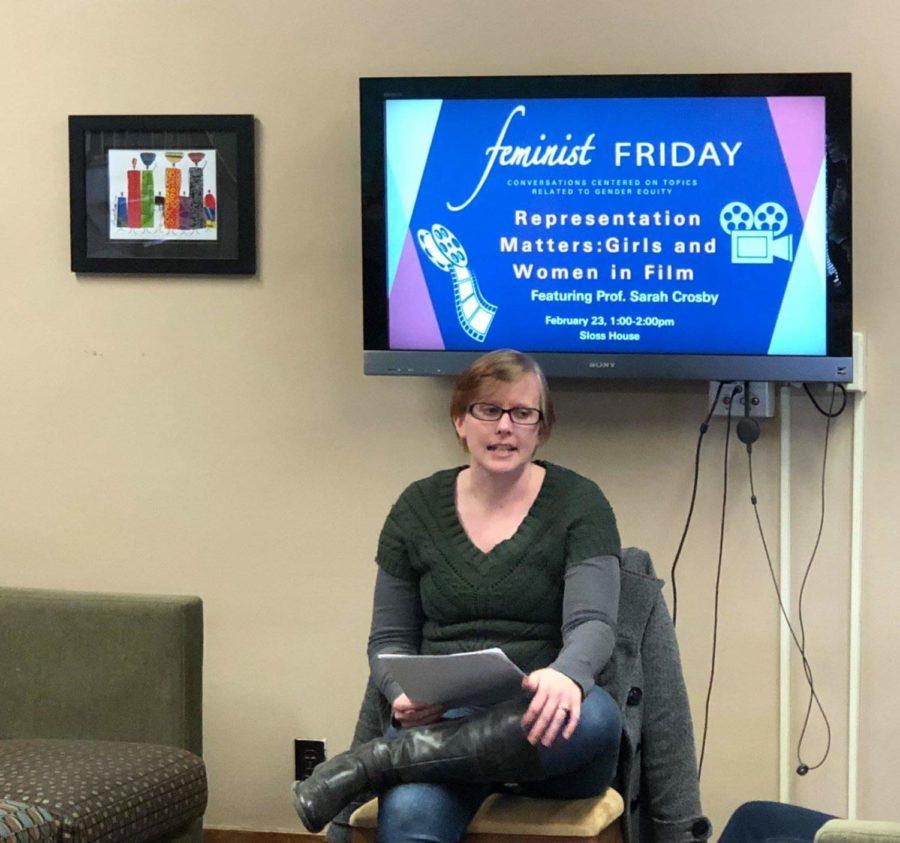Feminist Friday: Representation in Film
Sarah Chase Crosby addresses the crowd at Feminist Friday
February 23, 2018
66.5 percent men
33.5 percent women
2 percent LGBT
71.7 percent white
28.3 percent underrepresented
These totals were found from examining 11,306 speaking character roles from motion pictures and TV series in a study titled, “Inclusion or Invisibility? Comprehensive Annenberg Report on Diversity in Entertainment.”
These numbers show there is not equal representation in the films and television we watch.
At this week’s Feminist Friday, Sarah Chase Crosby, lecturer in the English department, tackled the topic of representation in film and discussed ways to critically think about it and ways to change it in the future.
Crosby’s thesis focused on gender in Disney films, specifically “Brave” and “Frozen,” along with gendered spaces, ecofeminism and third wave feminism.
“When did you see yourself represented as a kid?” Crosby said.
People in attendance saw themselves at different times, for example people who identify as white women, almost always saw themselves represented.
Crosby brought up the Star Wars series and how the original trilogy did not have the female representation or people of color representation, unlike the newer movies.
“When do we see ourselves and when don’t we see ourselves,” Crosby said. “Why is that?”
In more recent times, there are movies that have representation, such as “Moonlight,” “Hidden Figures” and “Black Panther.” Crosby also discussed how representation is important, but it is also important that people who are being represented are not being represented as the “token character” or a nonsignificant character.
“Making sure it’s not invisible,” Crosby said.
Along with gender, race and LGBTQA+ representation, other representation such as different cultures, ages, parenting styles and lifestyles are also important according to Crosby.
“We’re seeing this pattern of white cis straight folks, so one representation doesn’t mean, check we’re done, it’s ‘ok sweet we did this thing now how else do we need to represent the reality of folks who are around.’” Crosby said.
Other representation issues people in attendance see in films is accents. Despite being from other countries, most actors and actresses still use American accents instead of their native accents, such as European accents and Australian accents. Allowing different languages to be featured is also an issue Crosby brought up.
“Allowing kids those same opportunities to see themselves,” Crosby said.
As movies are working on representation on screen, there is also a disparity in representation behind the screen.
In a study titled the “2017 Hollywood Diversity Report,” done by the Ralph J. Bunche Center for African American Studies at UCLA, in 2015, of the 168 films examined, only 10.1 percent were directed by minorities. Women directed 7.7 percent of top films in 2015.
When watching films, there are different ways a person can critically examine the representation in the film. One way is the Bechdel Test. This tests movies based on three criteria: it has to have at least two women in it who talk to each other and they talk to each other about something besides a man.
A second test that has been proposed is the DuVernay test. Named after Ava Duvernay, a director, the test would look at the African-American representation in films.
A third test is the Vito Russo test. To pass this test, the film must: contain a character that identifies as LGBT, must not be solely defined by their sexual orientation or gender identity, and must be tied to the plot in a way that their removal would have a significant effect on the film.
Both the second and the third test are inspired by the Bechdel Test.
Over the years, representation has increased, female representation in films is at a historical high, and films like “Black Panther” and “A Wrinkle in Time” are working toward increasing representation but there is still work to be done, according to Crosby.







